: Are you a gardener searching for the perfect landscaping solution?
Slender Weavers bamboo is your answer. With its fast-growing nature and maximum height of 8m, it is a favorite among landscapers. Its lush evergreen foliage, green stems, and shallow root structure make it an ideal choice for any garden.
Transform your garden into a breathtaking oasis with Slender Weavers bamboo. Its rapid growth will provide quick privacy and create a stunning visual impact. The vibrant green stems and year-round foliage will add a touch of elegance to your outdoor space. Plus, its shallow root system ensures easy maintenance and compatibility with various soil types.
Take the first step towards a stunning garden transformation. Choose Slender Weavers bamboo today and experience the beauty and convenience it brings. Start creating your dream garden now!
6 Steps to Grow Slender Weavers Bamboo
Grow Slender Weavers Bamboo
6 Steps to grow Slender weavers bamboo
This is as easy as growing any regular plant.
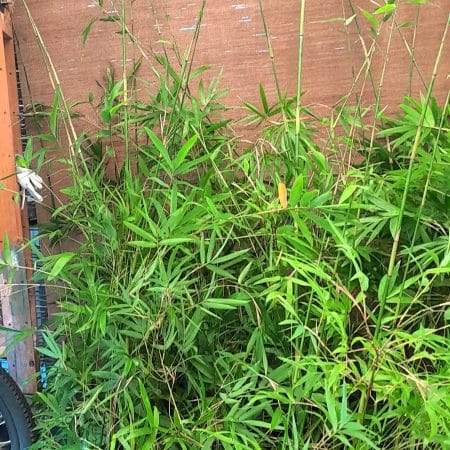

Total Time Needed :
30
Minutes
Total Cost:
65
USD
Required Tools:
Things Needed?
Care Guidelines: How to Grow Slender Weavers
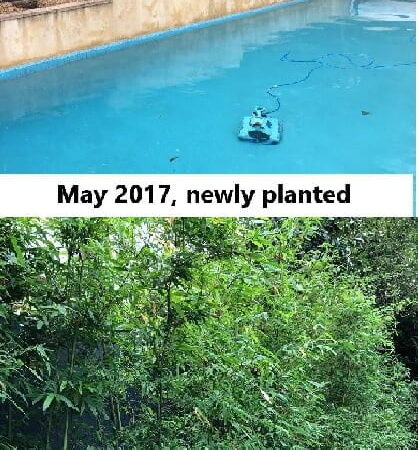

Free-draining soil is essential. Dig the planting holes, then fill them with water. If the water is still in the hole after 6-12 hours (very rare), then you need to improve the drainage.
If other common plants are growing well in the soil, then there shouldn’t be any issues. Do not mix in potting mix with the soil. Only mix in chicken manure, blood and bone or compost with the soil if you fully understand what you are doing.
Blood and bone, manure and compost work well put on top of the soil; this replicates what happens naturally as a result of 4 billion years of evolution.
There is no natural environment where large quantities of organic matter are dug into the soil. In almost every natural environment where life exists, organic matter is broken down through invertebrates and then microbial action and is incorporated into the soil structure.
One teaspoon of soil contains more bacteria than the entire human population. There are networks of fungi that connect the roots of plants in the soil (and we don’t yet fully understand how they work) This is probably a sign that the microbes are going to do a much better job than you at getting nutrients into the roots of the plants.
Bamboo plants love mulch. Start with 5 cm now, then increase to 10 cm. Keep the mulch topped up all around the plant. This will improve the soil for the reasons above.
Look at plants in containers as plants that will need a lot of attention. For growing in large containers, only buy a potting mix with this label/tag or made in bulk to this standard. 

If you need help with what to do, contact us.
If you need potting mix in bulk, contact Australian Growing Solutions, they have depots in Sydney, and their growth media is as good as their expertise.
Call them and explain what you are doing, and they will give you advice and a specific mix delivered by truck at a reasonable rate.
https://www.agsolutions.net.au/
Tel: 1800 709 588
Fax: 1800 709 688
sales@agsolutions.net.au
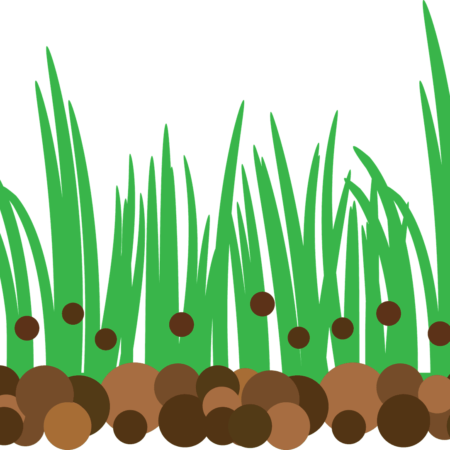

The best fertiliser which is readily available that we have used is Osmocote Controlled Release All Purpose Fertiliser which contains trace elements
https://www.bunnings.com.au/osmocote-9kg-all-purpose-landscape-fertiliser_p2980016
For the 1st season, it’s a good idea to use this by digging it into the planting hole. It guarantees that all trace elements will be available for the plants to establish. If your soil is poor, you can use it again for the second season.
The first and second seasons only 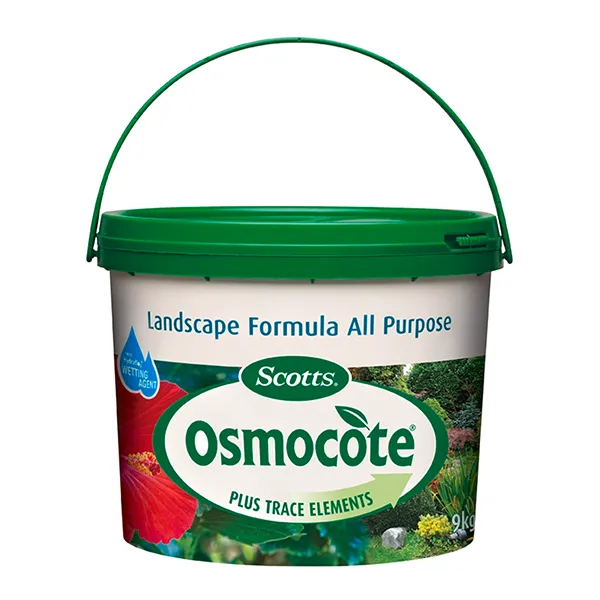

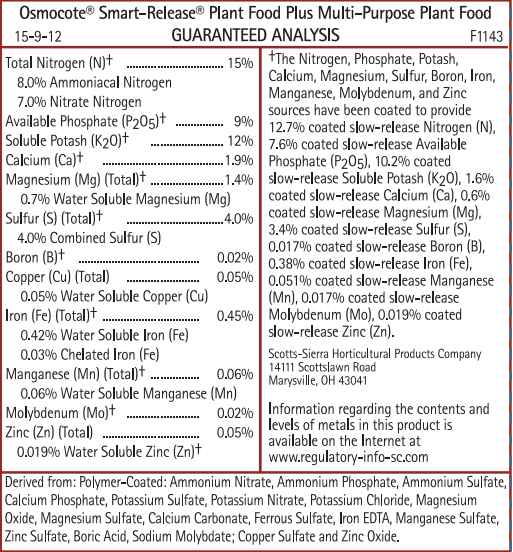

From the very beginning, organic fertiliser gives good results. Blood and bone, well-rotted compost and manure are good organic fertilisers and should be applied annually to create healthy and resilient plants.
Avoid soluble fertiliser if you want healthy soil.
They will do a great job of keeping your bamboo growing and keeping it healthy. You want healthy soil because it contains all the bacteria and fungi your bamboo naturally lives with (symbiotic relationship).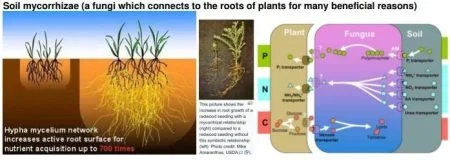

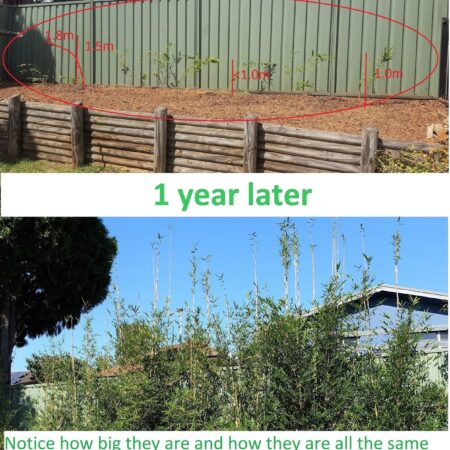

They will grow slowly (much faster than any other plant) for the first year.
Shoots may not appear for a few months after they first go into the ground, but the plants will be putting down roots and building up stores of energy before putting up their first shoots.
In year 2, they will grow much faster. From year three onwards, they begin to show the kind of growth rates that bamboo is famous for. You can remove old/small culms (canes) to maintain the vigour and appearance of the clump.
It’s recommended only to keep the culms needed for whatever effect you want. This reduces water and nutrient demand and there is no point in having a plant with 100 culms when a plant with 20 culms does the same job.
Similarly putting small plants in the ground now is going to give you the same result as putting slightly bigger plants in the ground in the future (obviously this is not true in all cases but it makes a point) The plants in the next photos were purchased by a customer who called to express disbelief that they would screen anything. 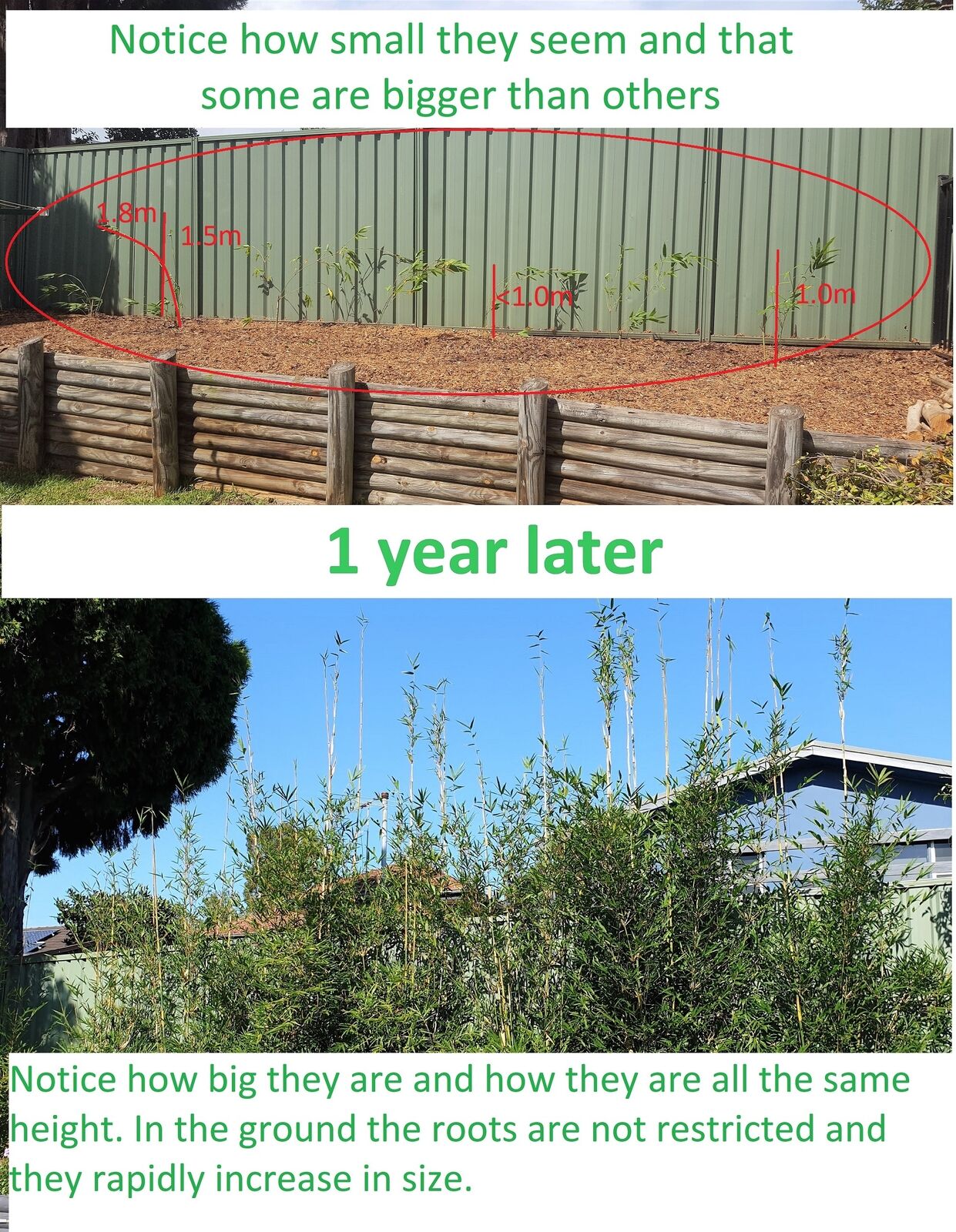

Less than two years later the customer took more photos and expressed disbelief at just how fast they grew. The thing to notice is the difference in the size of the initial plants and then notice that you can’t notice any difference in less than two years.
IPlastic pots and potting mixes are entirely artificial environments. They have no adaptations for growing in environments. n 200mm pots, most bamboo grows very slowly. Their roots are restricted, and they don’t want to be in the pot. 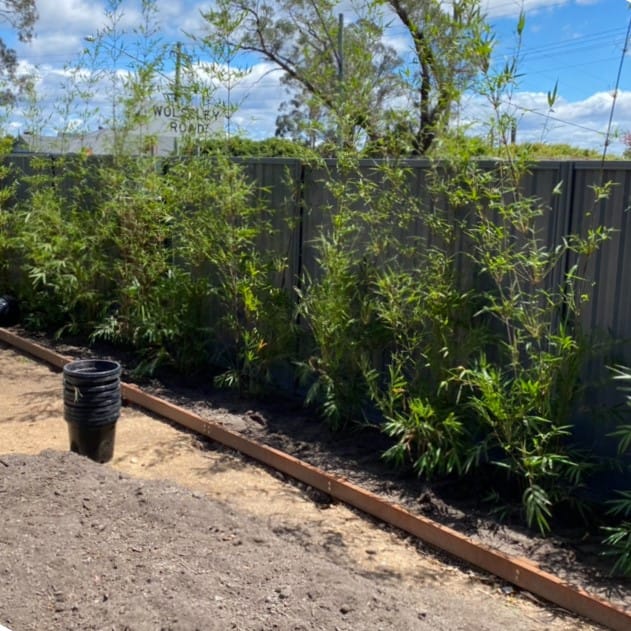

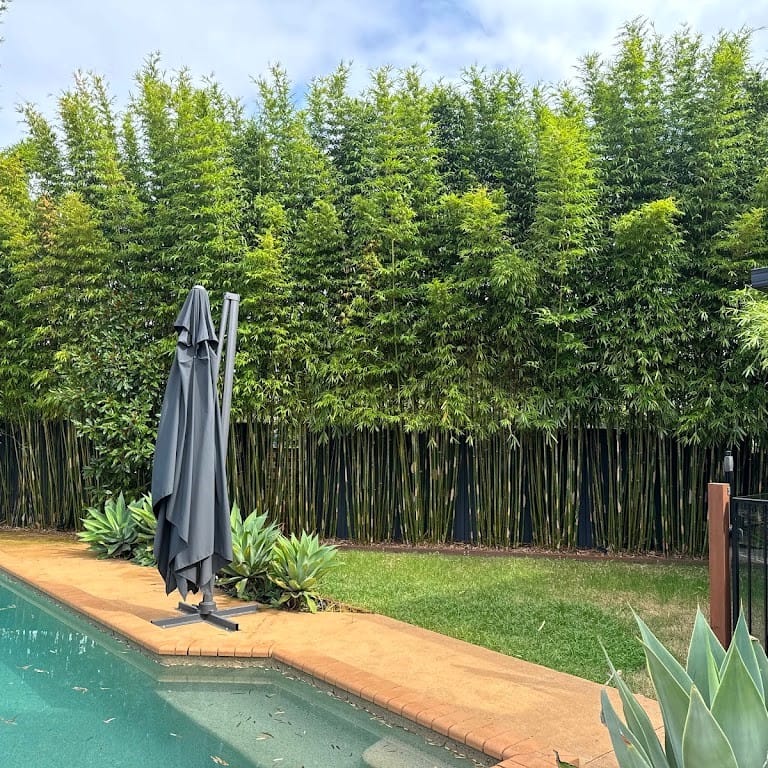

The minute the roots get used to being in the soil (not potting mix), they take off because they are in an environment that 4 billion years of evolution have selected for.
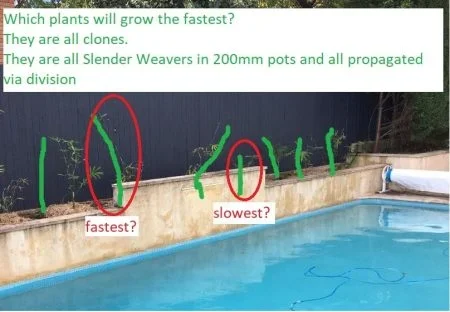

How many culms does each plant have? How tall are your plants?
Please take a moment to look at the initial size of the plants.
We usually send out plants much bigger than this, but these photos should be why it doesn’t matter. Look how the initial sizes are all quite different from each other.
Look how there is no visible effect on the final height.
The initial size only makes a real difference if they are too big, in which case they take longer to establish as the plant cannot get enough water into the new growth..
Each culm is taller than the last.
Plants with more space grow faster.
This means a smaller pot in a pot that still has plenty of room will get going much more quickly than a plant that has been left in a pot too long and has begun to slow down.
A 1m plant in a 200mm pot will put up a 1.5-1.8m shoot within a few weeks.
A 1.8m plant in a 200mm pot will struggle to put up another shoot; when it does, it won’t be much bigger than 1.8m.
If you plant both in the ground, the 1m plant will still be actively growing and will put up a shoot, which may well be closer to 2m if the roots sense freedom.
You will then be looking at a plant that has a 1m shoot and a 2m shoots and is actively looking to maximise the height of the next shoot, which may get close to 2.5 or 3m.
Meanwhile, the 1,8m plant will have been struggling to establish roots in the ground.
It will be able to get water up to the existing growth, but once it has an established root system, it will be easier to support much new growth.
This will result in the 1,8m plant taking several months to start growing correctly again, by which time the 1m plant will have overtaken it.
If it has started to put up more than one more shoot at 1.5-1.8m and the roots are heavily spiralled in the bottom of the pot, it will likely be stunted.


These plants have root systems that can grow down and out quickly.
These plants below would have been a nightmare to establish. They would have a lot of growth above ground and have died within 12 hours of a hot summer’s day because it’s impossible to keep the water up to them when they are not in a nursery getting watered constantly by a saucer or a dripper or six.


The best way to think about this is that a specific area of land has a particular amount of water and nutrients and an exact amount of sunlight falling on it. One plant that can fill that space will grow faster, taller and with longer branches and more leaves than two plants that compete with each other.
Generally, Slender Weavers go well planted 1.2-1.5m apart. Gaps at the bottom can be filled by cutting new culms down to about 3m just before they put branches out. This causes them to put branches out only from the lower section that’s left.
For Tiger Grass or Green Hedge, then about 1m is good
For B. oldhamii you need at least 3m between each plant to get the best out of them. For bigger plants or Painted bamboo, you should look at at least 5m between each clump, depending on what you are doing / what you want.
Generally, always leave more space than you think you need at the start.
Experienced gardeners/growers never really talk about when they gave plants too much space.
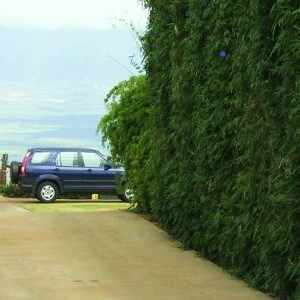

Slender Weavers bamboo – the perfect solution for gardeners seeking a fast-growing, low-maintenance plant that adds beauty and structure to their landscapes. With its lush evergreen foliage, vibrant green stems, and shallow root structure, Slender Weavers bamboo is the preferred choice of many landscapers.
Situation: Are you tired of waiting years for your plants to grow and fill out your garden?
Problem: Traditional plants can take ages to reach their full potential, leaving your garden looking bare and uninspiring.
Implication: This lack of visual appeal can dampen your enjoyment of your outdoor space and even deter visitors from appreciating your garden’s beauty.
Need: You need a plant that grows quickly and provides immediate results, transforming your garden into a vibrant oasis.
Payoff: Slender Weavers bamboo is the answer you’ve been looking for.
With its rapid growth rate and maximum height of 8m, Slender Weavers bamboo quickly fills out your garden, creating a lush and inviting atmosphere. Not only does it offer a solution to your landscaping needs, but it also brings numerous benefits.
The dense foliage acts as a natural privacy screen, shielding your garden from prying eyes and giving you a peaceful sanctuary. Its shallow root system prevents damage to surrounding structures, making it an ideal choice for small or confined spaces.
Imagine the joy of stepping into your garden and being greeted by a stunning display of vibrant green stems and feathery leaves that sway gently in the breeze. Slender Weavers bamboo not only enhances the aesthetics of your garden but also provides a soothing backdrop for relaxation and outdoor activities.
Don’t miss out on the opportunity to transform your garden into a breathtaking oasis in no time. Choose Slender Weavers bamboo and enjoy the immediate payoff of a beautiful, thriving landscape that will impress both you and your guests.